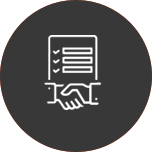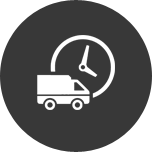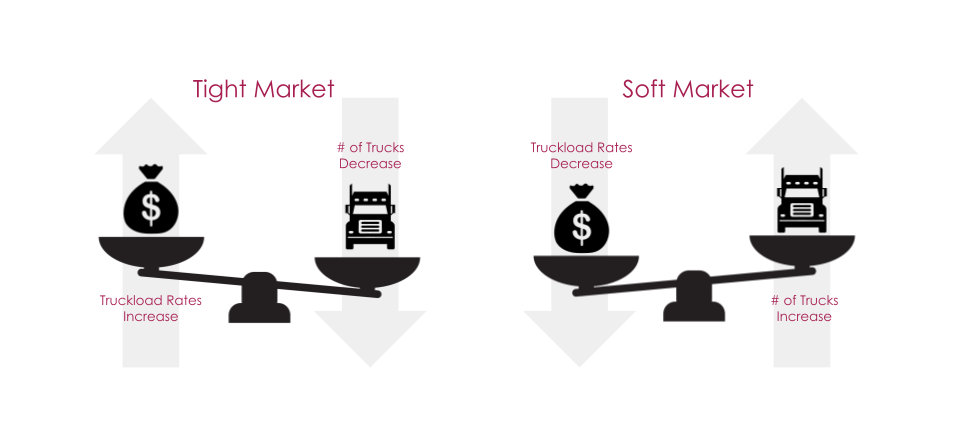Q2 2023
Freight Market Outlook
It’s currently a shipper’s market. But that can change quicker than we think.
 Sleek Leadership Prediction by Oleg Yanchyk, Sleek Technologies CIO
Sleek Leadership Prediction by Oleg Yanchyk, Sleek Technologies CIO
The freight market was tight for many consecutive quarters leading up to Q1 due to surges in demand based on pandemic-era capacity. This led to high truckload cost and greater profitability for 3PLs and carriers.

Since Q1 2023, dynamics have shifted as supply (# of carriers) outweighed demand (# of loads). Volumes have remained relatively flat with current volumes comparable to 2018/ 2019 levels but far below 2021/2022 levels. Ocean shipping rates have cooled down from over $11K on average per container in Q3 2022 to less than $1.5K in mid-March 2023. Month over month, the national spot rates for van have continued to drop. National spot rates (reported by DAT) were: Jan: $2.38, Feb: $2.26, March: $2.18, and April $2.13.
Moving into Q2, shippers will continue to experience softer market conditions. But there are a two things that shippers should keep in mind as they look to balance truckload cost with service levels both short and long term:
Win-Lost partnership strategies are short-sighted:
- Although it continues to be a shipper’s market, some shippers are pushing too hard and chasing rock bottom rates which can have a negative long-term impact on business- especially when the market rears its ugly head and begins to tighten up. For more info on this topic, read Tips to Create ‘Win-Win’ Partnerships For Long-Term Transportation Success.
Be on the lookout for scenarios that will help balance supply and demand, such as:
- Supply diminishes: higher fuel cost and inflation, increased regulation, overcapacity, and a cooling economy is squeezing smaller carriers off the road. Unlike larger fleets, smaller carriers can’t absorb operational costs, or operate at or near a loss to win contracts. As more and more trucks idle, truckload prices will begin to rise.
- Demand increases: typically in Spring, we see seasonal production spikes in produce and building/construction which will help trucking demand recover.
-
Understanding The Freight Market
Also referred to as transportation management, freight procurement is the process of finding, vetting, and transacting with trucks & drivers (also known as carriers) to move company goods (also known as loads, shipments, or freight) from one location to another. Truckload cost is driven by supply and demand.
Supply is defined as the total number of carriers available.
Demand is defined as the total number of shipments that need to move.
Shippers who have embraced tools to effectively navigate freight market cycles have no problem delivering goods on time, and paying a fair market price– no matter the market condition. This resource page helps shippers understand:

Freight market dynamics

How freight market fluctuation impacts shippers

Tips on how shippers can overcome freight market volatility
Freight Market Dynamics
The freight market is similar to the stock market. Supply and demand drive truckload cost. The balance between supply and demand can change at any moment due to a variety of factors, including but not limited to conflict, the economy, natural disasters, labor strikes, and seasonality.
Therefore, truckload price is extremely variable, Logistics Management called it “emulating a boom-and-bust cycle”. When there’s excess supply (carriers) and rates fall, trucking companies exit the market. When rates rise, new trucking companies enter the market until carrier saturation occurs and rates fall back down again. It’s a vicious cycle. The key is to find ways to stay on top of freight market twists and to pivot quickly with little notice. Remaining static is not sustainable because freight supply and demand hardly come and stay in equilibrium.
What Impacts Freight Market Supply and Demand?
![]()
Freight Market Supply (# of carriers):
As freight demand slows, and operational cost remains high, smaller trucking companies will be forced to fold. Drivers leave the trucking industry for other jobs.
As freight demand spikes, it’s been hard to recruit new drivers (the younger generation). To help combat this problem, trucking companies have continued to up the ante with more incentives like higher pay with hopes to increase the number of young workers who want to pursue a career in trucking.
![]()
Freight Market Demand (# of loads):
Changes in employment levels, and consumer purchasing power, impact freight market demand. For example, when people buy more, manufacturers need to produce and therefore ship more goods.
Seasonality impacts freight market demand. Here are four primary freight market seasons: Season 1 (January–March): Demand is usually lower due to post-holiday recovery and bad weather, which triggers softer market conditions. Usually considered the quiet period, this is a great time to uncover gaps and implement new tools to prepare for busier times ahead. Season 2 (April–July): Demand is usually higher due to the produce season, which triggers tighter market conditions. Season 3 (August–October): Demand increases due to back-to-school shopping and holiday preparation, which trigger tighter market conditions. While the holidays are months away, shipping between manufacturers, distributors, warehouses, and retail locations begins in August to prepare for the busiest time of year. Season 4 (November–December): Demand spikes due to high consumer buying power in key industries such as retail, food, beverage, paper, and packaging.
Tips on How Shippers Overcome Freight Market Fluctuation
Transportation teams are deemed successful when they deliver goods on time (100% OTD), while paying a fair truckload cost (managed transportation budget). But with fluctuating freight market dynamics, this is difficult if the team does not have the proper tools to manage volatility on the fly. Forward-thinking shippers understand the latest technological advancements and embrace the need for change to reduce waste and increase profitability. If your transportation team’s mindset, processes, and/or tools have not changed in recent years you are missing out on high-potential cost-reduction opportunities.
Here are 2 new freight procurement innovations that have helped many large shippers uncover resilience, sustainability, and cost reduction opportunities to stay ahead of any freight market condition.
![]()
Freight Procurement Automation:
Transformational AI-powered software has upended the existing freight procurement paradigm which limits the total number of carriers a shipper can effectively manage and transact with. The software instantly finds, vets, and transacts with any carrier across America. Gone are the days of long hours onboarding new carriers, it can now be done within seconds. To read more about carrier onboarding, click here.
Shippers can now supplement RFPs and brokers by dynamically matching loads to the right carrier… at the right time… and at the right price. By doing so, shippers have reduced labor cost by 30%, reduced truckload cost by 20%, and strengthened on-time delivery (OTD) to 98%+. To check out shipper success stories, click here.

Freight Procurement Analytics:
Most shippers rely on historical 1st party data, and/or market averages to make important freight procurement decisions. Without actionable, real-time data, the transportation team can not respond quickly to unexpected shifts in freight market supply and demand.
With the onset of automation, data collection and centralization has occurred. Forward-thinking shippers have partnered with companies that provide 100% freight data transparency to obtain advanced truckload data resulting in stronger, informed, data-driven decision-making. Plus, executive-level reporting can be filtered for custom storytelling to effectively report up and out. To see sample reports, click here.
Transportation teams are on overload. Lack of resources is one of the key reasons why transportation is forced to restrict the number of carriers they interact with. They place all their eggs in one basket by relying on less than 6% of the total truck universe. This makes it impossible to achieve their goals of delivering goods on time at fair market cost.
 Reduce Costs
Reduce Costs
Save when our instantly bookable rates are lower than your static backup.
 Save Time
Save Time
Loads tendered to Loadsmart are accepted instantly, helping you save bandwith and avoid pricey same-day/next-day rates.
 Instant, Reliable Capacity
Instant, Reliable Capacity
Access instant pricing for a carefully vetted network of over 750,000+ trucks including FTL, LTL, and PTL.
 No cost, quick setup
No cost, quick setup
Pre-built, no-cost TMS integrations that are fast and easy to enable with no obligation to move a load.
Privacy Policy | Terms of Service
© 2023 Sleek Fleet, DBA Sleek Technologies. All Rights Reserved.

